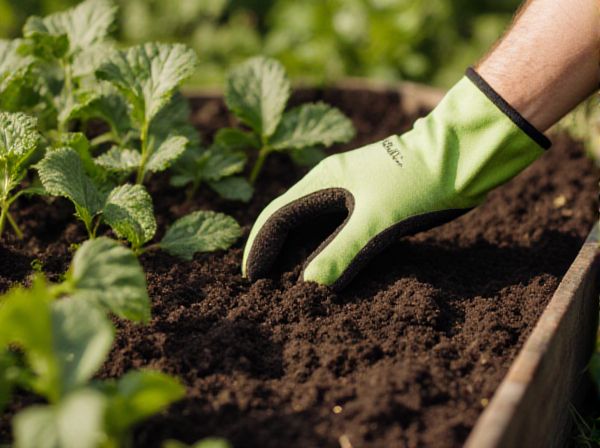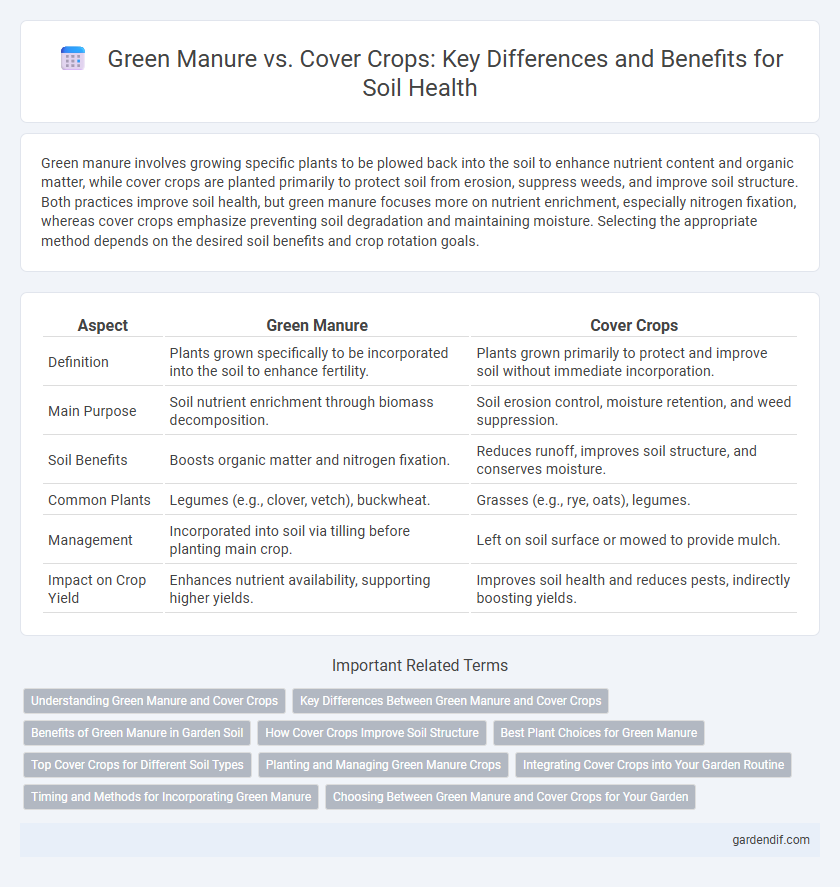
Green manure vs Cover crops Illustration
Green manure involves growing specific plants to be plowed back into the soil to enhance nutrient content and organic matter, while cover crops are planted primarily to protect soil from erosion, suppress weeds, and improve soil structure. Both practices improve soil health, but green manure focuses more on nutrient enrichment, especially nitrogen fixation, whereas cover crops emphasize preventing soil degradation and maintaining moisture. Selecting the appropriate method depends on the desired soil benefits and crop rotation goals.
Table of Comparison
| Aspect | Green Manure | Cover Crops |
|---|---|---|
| Definition | Plants grown specifically to be incorporated into the soil to enhance fertility. | Plants grown primarily to protect and improve soil without immediate incorporation. |
| Main Purpose | Soil nutrient enrichment through biomass decomposition. | Soil erosion control, moisture retention, and weed suppression. |
| Soil Benefits | Boosts organic matter and nitrogen fixation. | Reduces runoff, improves soil structure, and conserves moisture. |
| Common Plants | Legumes (e.g., clover, vetch), buckwheat. | Grasses (e.g., rye, oats), legumes. |
| Management | Incorporated into soil via tilling before planting main crop. | Left on soil surface or mowed to provide mulch. |
| Impact on Crop Yield | Enhances nutrient availability, supporting higher yields. | Improves soil health and reduces pests, indirectly boosting yields. |
Understanding Green Manure and Cover Crops
Green manure consists of specific plants grown primarily to be plowed back into the soil, enhancing nutrient content and organic matter. Cover crops are planted mainly to protect and improve soil structure by preventing erosion, suppressing weeds, and retaining moisture. Both practices contribute to sustainable soil management but differ in their primary purposes and timing within crop rotations.
Key Differences Between Green Manure and Cover Crops
Green manure consists of specific plants grown primarily to be incorporated into the soil to improve fertility and organic matter, while cover crops are planted mainly to protect soil from erosion, suppress weeds, and retain moisture. Green manure typically involves leguminous plants like clover or alfalfa that fix nitrogen, enhancing nutrient availability, whereas cover crops can include grasses like rye or oats focusing on soil coverage and structure. The main distinction lies in green manure's intentional soil enrichment versus cover crops' broader role in soil conservation and ecosystem balance.
Benefits of Green Manure in Garden Soil
Green manure improves garden soil by enhancing nutrient content, particularly nitrogen, through the natural process of nitrogen fixation by legumes. It boosts organic matter, which increases soil moisture retention, structure, and microbial activity essential for healthy root development. Incorporating green manure reduces erosion and suppresses weeds, leading to a more fertile and sustainable garden ecosystem.
How Cover Crops Improve Soil Structure
Cover crops enhance soil structure by increasing organic matter content and promoting aggregate stability, which improves water infiltration and retention. Their root systems create channels that aerate the soil, reduce compaction, and support beneficial microbial activity. This leads to healthier soil ecosystems and improved nutrient cycling compared to green manure alone.
Best Plant Choices for Green Manure
Legumes such as clover, vetch, and beans are the best plant choices for green manure because they fix atmospheric nitrogen, enriching soil fertility naturally. Fast-growing cereals like rye and barley are also effective for biomass production, improving soil structure and organic matter content. Selecting plant species based on soil type, climate, and desired nutrient contribution optimizes green manure benefits in sustainable agriculture.
Top Cover Crops for Different Soil Types
Top cover crops such as clover, rye, and vetch improve soil structure, enhance nutrient cycling, and prevent erosion across various soil types. In sandy soils, deep-rooted cover crops like alfalfa promote water retention and organic matter accumulation, while in heavy clay soils, legumes improve nitrogen fixation and soil aeration. Selecting green manure species tailored to specific soil characteristics maximizes benefits for soil fertility and crop productivity.
Planting and Managing Green Manure Crops
Planting green manure crops involves selecting fast-growing legumes or grasses that enhance soil nitrogen through biological fixation and organic matter addition. Proper management includes timely incorporation of biomass into the soil before flowering to maximize nutrient availability and prevent competition with cash crops. Regular monitoring of soil moisture and pest presence ensures optimal growth and soil enrichment benefits.
Integrating Cover Crops into Your Garden Routine
Integrating cover crops into your garden routine improves soil health by enhancing organic matter, increasing nitrogen fixation, and suppressing weeds without the need for synthetic fertilizers. Unlike green manure, which is typically tilled into the soil before planting, cover crops provide continuous soil protection by preventing erosion and maintaining moisture levels throughout the growing season. Selecting species like clover, rye, or vetch ensures nutrient cycling and promotes beneficial microbial activity, leading to sustainable garden productivity.
Timing and Methods for Incorporating Green Manure
Green manure is typically incorporated into the soil shortly before planting cash crops to maximize nutrient release and organic matter enrichment, usually through shallow tillage or plowing. Cover crops are often left on the surface as mulch or terminated using roller-crimping methods without immediate soil incorporation. Timing green manure incorporation correctly enhances nitrogen availability and improves soil structure, while cover crops primarily protect soil from erosion and suppress weeds during off-seasons.
Choosing Between Green Manure and Cover Crops for Your Garden
Green manure and cover crops both improve soil fertility but serve different purposes; green manure crops like clover and vetch are grown specifically to be tilled into the soil to increase organic matter and nitrogen content. Cover crops such as rye and buckwheat primarily protect the soil from erosion, suppress weeds, and retain moisture during off-seasons. Gardeners should select green manure when boosting nutrient levels is a priority and opt for cover crops when soil protection and weed control are the main goals.
Green manure vs Cover crops Infographic

 gardendif.com
gardendif.com